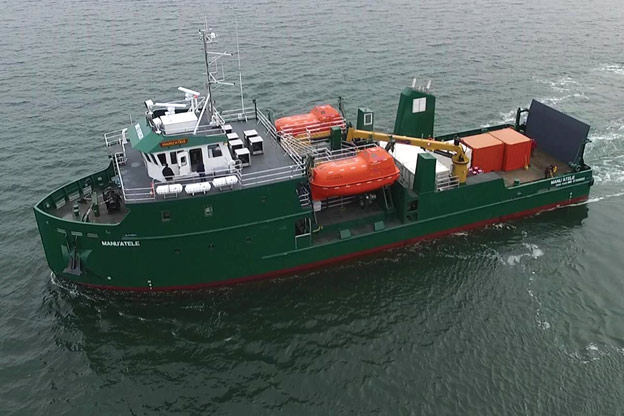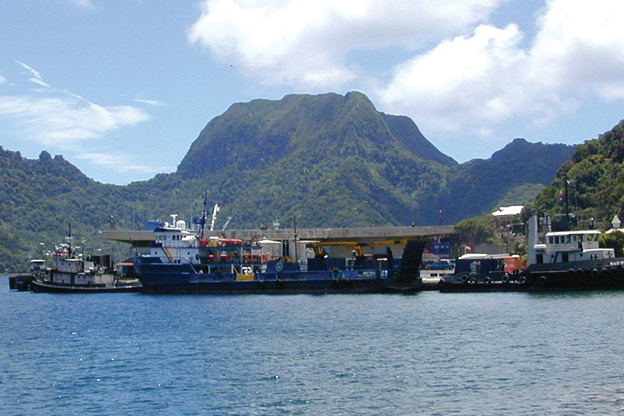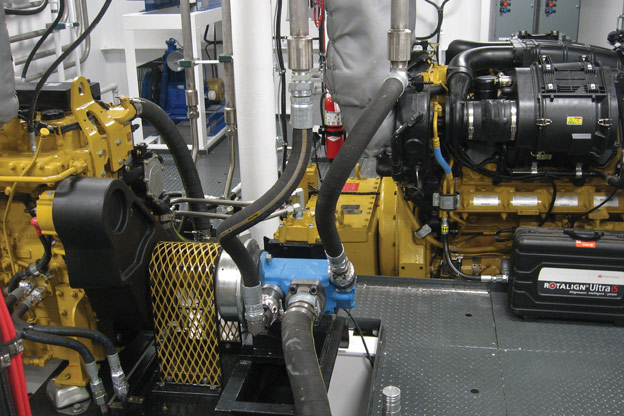Cruising through the islands of the South Pacific is every sailor’s dream, though I must admit it will likely remain just a dream for me. So when I was offered the opportunity to tour a new ferry boat built locally for service in American Samoa, I reckoned this might be the closest I could get to voyaging to those faraway islands. Of course I would have preferred to get a ride in an outrigger canoe across a lagoon, but reaching Whidbey Island where the 140-foot M/V Manu’atele was docked was not quite that exotic!
 Fortunately, there is a Washington state ferry to Whidbey Island that leaves every half hour from Mukilteo, just 25 miles from Northwest Yachting’s office in Ballard. Unfortunately, the weather was far removed from tropical and it was raining hard when I arrived in Langley on the south end of the island. This is where Nichols Brothers Boat Builders berths its newly-launched products for final finishing and sea trials.
Fortunately, there is a Washington state ferry to Whidbey Island that leaves every half hour from Mukilteo, just 25 miles from Northwest Yachting’s office in Ballard. Unfortunately, the weather was far removed from tropical and it was raining hard when I arrived in Langley on the south end of the island. This is where Nichols Brothers Boat Builders berths its newly-launched products for final finishing and sea trials.
Nichols builds every kind of commercial boat up to about 300 feet long, and their ferries range from high-speed aluminum catamarans to steel Washington State Ferry (WSF) car ferries. In the last decade they have built the superstructures for five ferries, including the two running that day on the Whidbey Island crossing. But the Manu’atele is unlike anything I have ever seen in 30 years covering commercial craft. She is a multi-purpose vessel specially designed to replace the M/V Sili, a 30-year-old rig supply boat that operates between the capital Pago Pago on Tutuila Island and the Manu’a Islands.
This weekly service is on a 60-mile route that involves transiting coral reef passes and maneuvering in very tight harbors. After many discussions between the Samoan government’s representatives and the naval architects in Washington, the maximum size was established to be 140′ length and an 8.5’ draft loaded, with a 38’ beam. The shallow draft was achieved with a hard-chine steel hull with low deadrise.
The Manu’atele is one of the very few small ships built in the Pacific Northwest that is American-flagged, carries passengers, and travels on the open ocean to other island nations like Tonga and Fiji. An alphabet soup of international regulations covers this type of ship, large or small. The construction must comply with USCG Subchapter T, plus many additional rules including SOLAS (Safety Of Life At Sea) which requires that the central deck area is surrounded by railings to form a secure mustering station where the lifeboats can be easily boarded.
MARPOL (Marine Pollution) is a convention about avoiding fuel spills that results in all fuel valves, vents, and hoses being located behind an overflow barrier along the aft wall of the superstructure. The ship also acts as a floating gas station with a system to measure fuel as it is pumped ashore. Modern computer-aided design (CAD) methods have helped to clean up all this piping and the layout of the engine room, allowing all the plumbing and wiring to be grouped into very neat runs.
The mains are two 850-horsepower Caterpillar C32 ACERT Tier 3 engines, with Twin Disc MGX-5225 DC; 4.03:1 reduction gears and 60”- diameter screws from Sound Propellers. The generators are a pair of 99 ekW Caterpillar C4.4’s, and there is plenty of room to walk between all four power plants. For safety and reliability, there are hydraulic pumps on all four engines to make sure the Kobelt wheel steering, bow thruster, crane, ramp, etc., can be operated at all times.
 Keeping cool below deck is not easy in the tropics, even in a sailing yacht, so the forward seating area for 120 passengers is air-conditioned, and there is a bank of six domestic fans aft of the wheelhouse to cool the lower decks and engine room.
Keeping cool below deck is not easy in the tropics, even in a sailing yacht, so the forward seating area for 120 passengers is air-conditioned, and there is a bank of six domestic fans aft of the wheelhouse to cool the lower decks and engine room.
“If you have been on the M/V Sili, passengers sit on the bottom and second level on bench-style seats that are very uncomfortable,” said the government’s port administration director Taimalelagi Dr. Claire Poumele. “On the Manu’atele all the chairs are individual and cushioned and the equipment is modern and computerized.”
Accommodation for eight crew is on the main deck, with a large galley filled with commercial-grade appliances that are usually seen on tugs and seiners. To enable the ship to handle cargo of all kinds at small docks, the deck is laid out in an unusual way. At the stern is a large ramp allowing beach loading onto an 1,840 sq ft. cargo deck. The 15-ton capacity North Pacific crane is used to hoist vehicles, pallets, and small 10-foot containers from a dock.
The Manu’atele costs about $13 million and was expected to depart from the Pacific Northwest last December with a stop in Honolulu for re-fueling. Pago Pago, the capital of American Samoa, is 2,400 miles SW and latitude 14° south. It will make weekly trips around Tutuila, calling at the north coast villages of Afono, Vatia, and Fagasa, then crossing open water to the three Manu’a Islands, which are the peaks of a huge extinct volcano rising from the floor of the Pacific. The culture here is traditional in that all the land of is owned communally by local families, including the National Parks lands that are only leased to the federal administration for 50 years.
The Manu’a Islands—a Remote Polynesian Paradise
However, I had never even heard of cruising yachts visiting this archipelago before, and decided to do a little research to learn more about where the Manu’atele is going to call home. These islands are the only inhabited territory of the United States in the Southern Hemisphere. Forty miles to the west is the biggest of the Samoan Islands, which are now the independent nation of Samoa. Most of the population of this region is Polynesian and they have preserved a culture known as fa’a Samoa (The Samoan Way) and an indigenous form of governance called fa’amatai–the chief system that is central to the organization of their society.
From a tourism point of view, I was really surprised to find the Lonely Planet guidebook says, “These are among the most ravishing—and remote—of all the Pacific isles.” Another visitor ranked Ofu Beach as one of the one of the top undiscovered beaches in the world with snorkeling that is fantastic and stunning scenery. A visit isn’t complete without jumping off the bridge that connects Ofu and Olosega. Along the rocky coastline, sea cliffs rise up to the 3,000 foot summit of Lata Mountain and 28 miles east of Ta’u, the Vailulu’u Seamount, an active submerged volcano, rises from the seafloor over three miles (16,000 feet) deep.
It was only discovered in 1975 and has been studied by an international team of scientists contributing towards understanding of the Pacific “Ring of Fire.” An active underwater volcanic cone is growing inside the crater of Va’ilulu’u, which is named after the Samoan goddess of war, Nafanua. It was most recently sounded at less than 2,000 feet from the surface, and some researchers have calculated that the it may breach the surface before the end of this century. The islands are still seismically active and the 2009 Samoa earthquake and tsunami killed more than 170 people in the region. That natural disaster and the threat of typhoons may keep tourists and cruisers away, making this tiny U.S. territory one of the least know but most beautiful destinations in the vast South Pacific—whether you arrive by sail or ferryboat!
Tropical Island Goes Solar
 Like any vessel, the Manu’atele has her fuel and energy demands. As it turns out, the energy supply of the America Samoa is a story unto itself. The island’s population of less than 1,000 people has relied almost entirely on diesel generators for electricity, running on fuel shipped in by the M/V Sili. This made their energy operation expensive at nearly $110,000 per year, and time-consuming to keep the tanks filled. The electric utility on American Samoa’s eastern most island, Ta’u, is now based on a new solar-powered 1.4 megawatt microgrid and battery system with six megawatt hours of storage. This is enough to power the entire island night and day according to the supplier, Solar City, recently acquired by electric car company Tesla. An array of 5,000 solar panels is backed up by 60 Tesla Power pack battery-storage systems that can recharge in seven hours and provide Ta’u with three full days of power without sun. The new solar microgrid could also cut carbon dioxide emissions by about 2.5 million pounds—an important point in a country threatened by sea level rise.
Like any vessel, the Manu’atele has her fuel and energy demands. As it turns out, the energy supply of the America Samoa is a story unto itself. The island’s population of less than 1,000 people has relied almost entirely on diesel generators for electricity, running on fuel shipped in by the M/V Sili. This made their energy operation expensive at nearly $110,000 per year, and time-consuming to keep the tanks filled. The electric utility on American Samoa’s eastern most island, Ta’u, is now based on a new solar-powered 1.4 megawatt microgrid and battery system with six megawatt hours of storage. This is enough to power the entire island night and day according to the supplier, Solar City, recently acquired by electric car company Tesla. An array of 5,000 solar panels is backed up by 60 Tesla Power pack battery-storage systems that can recharge in seven hours and provide Ta’u with three full days of power without sun. The new solar microgrid could also cut carbon dioxide emissions by about 2.5 million pounds—an important point in a country threatened by sea level rise.


